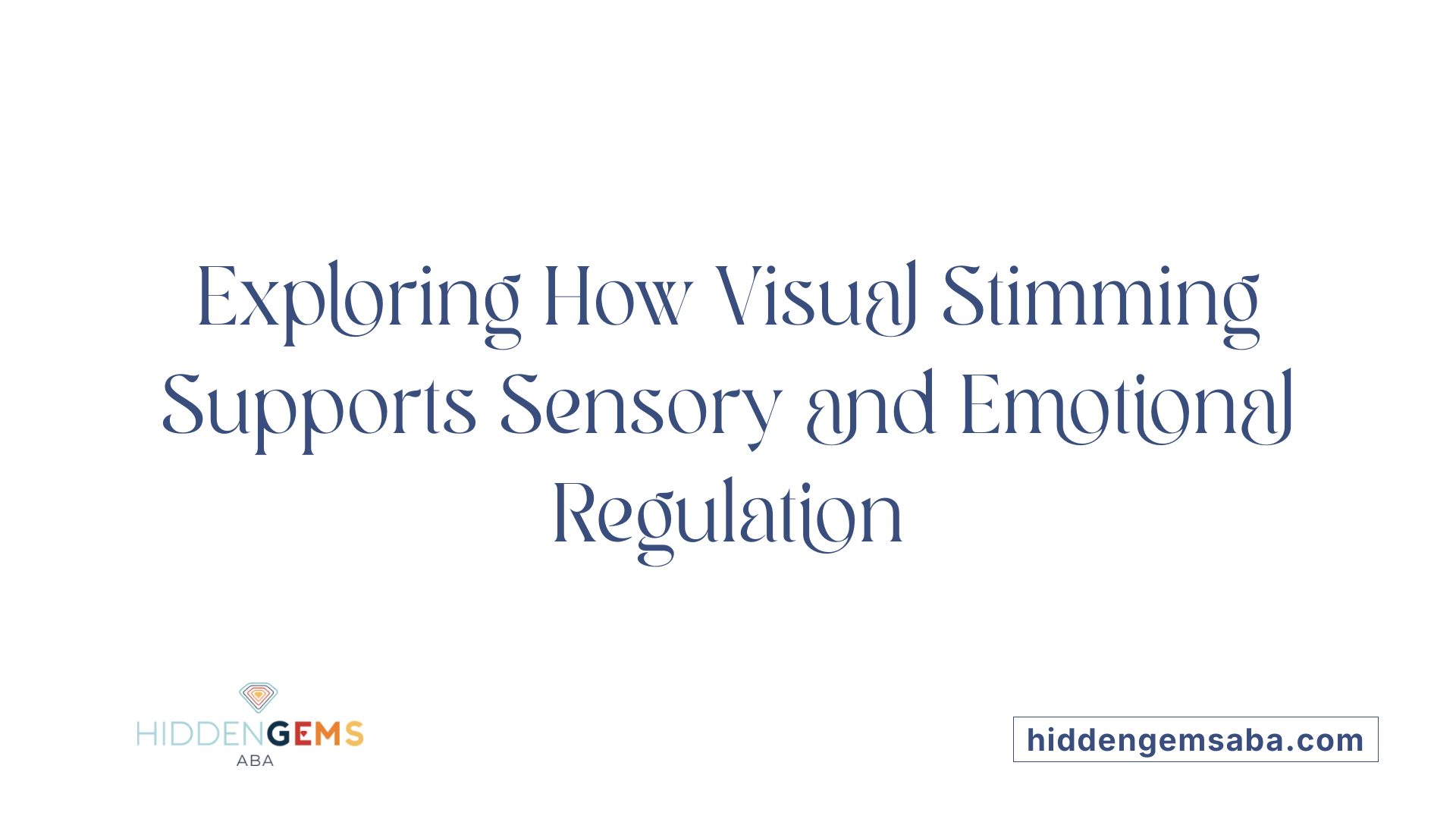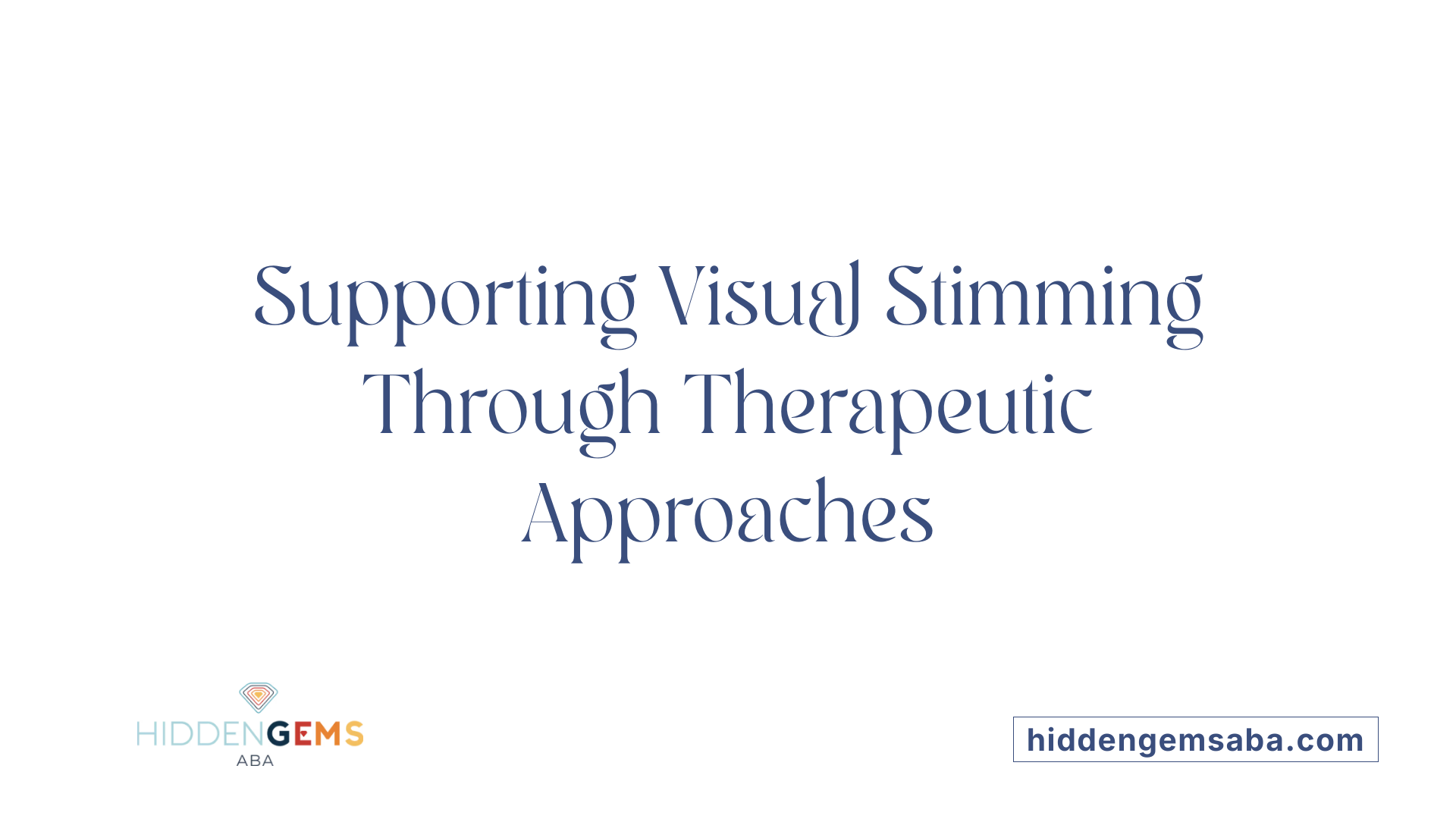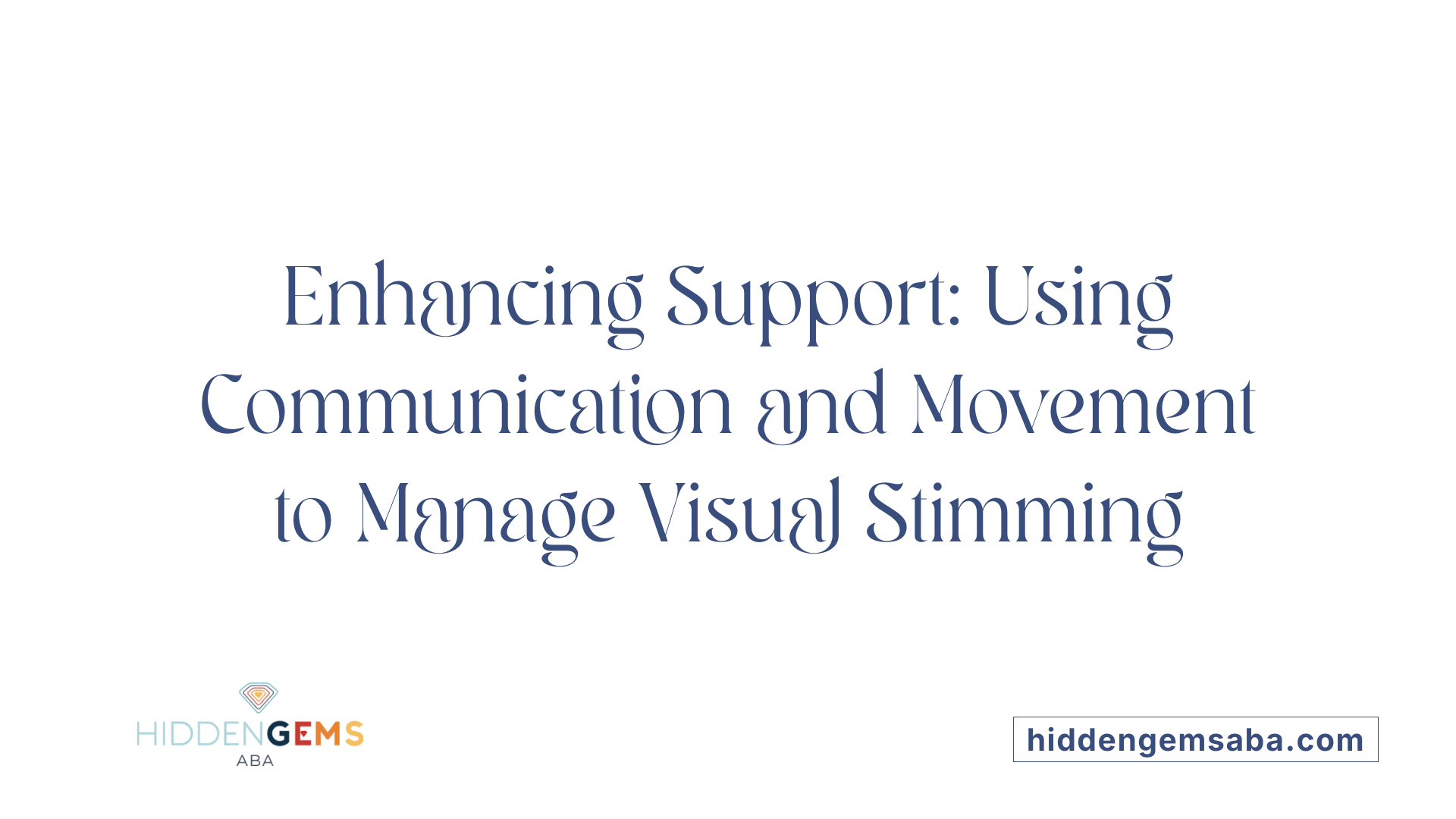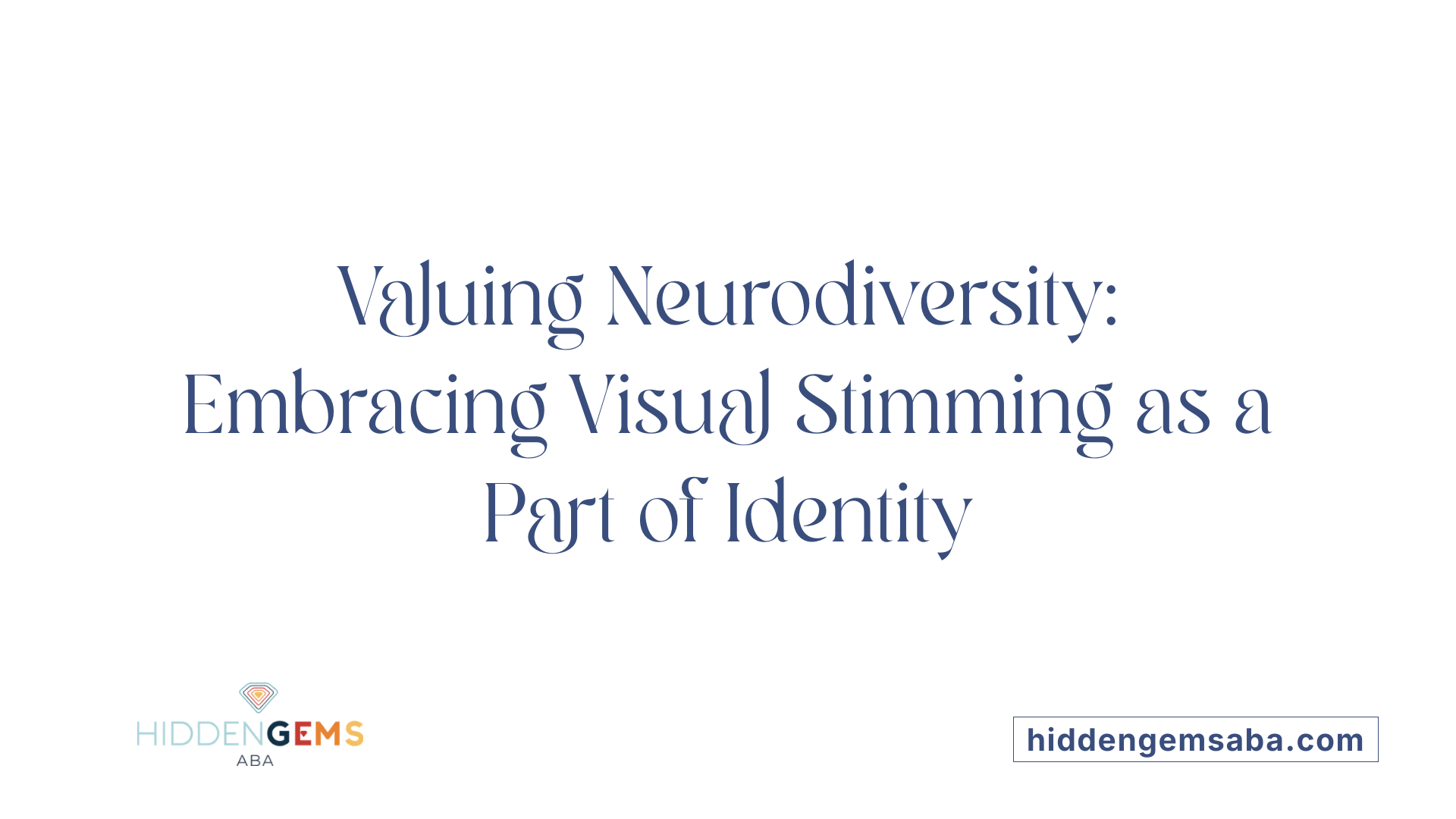Exploring the Role of Visual Stimming in Autism Spectrum Disorder
Visual stimming, a common behavior among individuals with autism, involves repetitive visual actions such as watching spinning objects or flickering lights. This behavior serves important functions including sensory regulation, emotional expression, and stress reduction. This article delves into the nature of visual stimming, its underlying reasons, and evidence-based interventions that respect neurodiversity while supporting individuals’ well-being.
What is Visual Stimming and Why Does it Occur?

What Are Stimming Behaviors in Individuals with Autism?
Stimming behaviors are repetitive movements, sounds, or actions that individuals with autism engage in to help manage their emotions, process sensory experiences, or reduce stress. These behaviors are a common way for individuals to cope with sensory overload or emotional challenges.
Types of Visual Stimming
Visual stimming specifically refers to behaviors that provide visual sensory input. Common examples include watching spinning objects like wheels or toys, fixating on flickering lights, or repeatedly looking at patterns and reflections.
Why Does Visual Stimming Occur?
Visual stimming serves important functions such as sensory regulation, helping individuals with autism manage overwhelming sensory environments. It also supports emotional expression and self-soothing by offering predictable and calming visual stimuli.
The Role of Visual Stimming in Sensory and Emotional Regulation
For many on the autism spectrum, visual stimming helps to balance the sensory input they receive, reducing feelings of anxiety or distress. Engaging in these repetitive visual actions can make their surroundings feel more controllable and predictable, improving overall emotional wellbeing.
Understanding these behaviors as natural and purposeful is crucial for developing respectful interventions that support individuals’ needs without attempting to suppress helpful coping strategies.
The Sensory and Emotional Functions of Visual Stimming

How does visual stimming help individuals with autism?
Visual stimming involves repetitive visual behaviors such as watching spinning objects or flickering lights. For individuals with autism, this form of stimming plays an important role in managing sensory input. It provides calming sensory experiences that help reduce anxiety and express emotions. By engaging in visual stimming, individuals can self-soothe and regulate overwhelming or unfamiliar sensations in their environment.
Sensory processing and regulation
Autistic individuals often experience sensory processing differences, which can lead to sensory overload. Visual stimming offers a predictable and controllable sensory input that helps balance these sensory challenges. This regulation supports their ability to function comfortably in daily life.
Emotional self-regulation and self-soothing through visual stimming
Beyond sensory regulation, visual stimming aids emotional self-regulation by helping individuals manage stress and emotional responses. Through self-soothing, these repetitive visual behaviors serve as a natural coping mechanism, reducing feelings of distress.
What does research say about the nature of stimming?
Research has shown that stimming behaviors are often automatic and involuntary. These actions serve as calming, self-regulatory mechanisms, particularly when individuals encounter sensory overload or chaotic surroundings. Recognizing this helps in developing interventions that respect and accommodate these behaviors rather than trying to suppress them, unless they pose safety concerns.
Visual stimming is a meaningful, functional behavior deeply connected to sensory and emotional wellbeing in autism. Appreciating its role is essential for creating supportive, compassionate care environments that honor neurodiversity.
Applied Behavior Analysis (ABA): Understanding and Supporting Visual Stimming
How does ABA therapy support individuals who engage in visual stimming?
Applied Behavior Analysis (ABA) therapy plays a vital role in supporting individuals with autism who exhibit visual stimming behaviors, such as watching spinning objects or flickering lights. Through a thorough Functional Behavior Assessment (FBA), ABA therapists identify the triggers and purposes behind these repetitive visual actions. This foundational step allows them to understand whether the behavior serves sensory regulation or emotional self-soothing.
ABA then uses positive reinforcement techniques to encourage desirable behaviors while teaching replacement behaviors that fulfill the same sensory or emotional needs in safer or more socially acceptable ways. Rather than aiming to suppress stimming outright, ABA promotes acceptance and accommodation, recognizing stimming as a natural and functional part of sensory processing for many individuals.
What is the goal of interventions regarding stimming behaviors?
The principal goal of interventions involving stimming behaviors is not to eliminate them but to understand their underlying function. Stimming often provides crucial self-soothing and emotional regulation, especially during sensory overload or stressful situations. Interventions focus on maintaining this balance by respecting the individual’s need for stimming while ensuring safety and minimizing disruption to daily life.
ABA therapy, in particular, emphasizes creating a supportive environment where stimming is managed thoughtfully. This balanced approach helps individuals navigate their surroundings comfortably, fostering skill development without compromising their natural ways of coping. Acceptance combined with targeted support allows for improved communication and self-regulation, enhancing overall quality of life.
| ABA Therapy Element | Description | Purpose |
|---|---|---|
| Functional Behavior Assessment (FBA) | Identifies triggers and the function of visual stimming behaviors | Understand why stimming occurs to target effective interventions |
| Positive Reinforcement | Rewards alternative or appropriate behaviors | Encourages development of replacement skills |
| Replacement Behaviors | Teaches safer or socially acceptable responses to sensory needs | Provides alternatives without suppressing the need to stim |
| Balanced Accommodation | Supports acceptance of stimming | Respects neurodiversity while ensuring safety and comfort |
Complementary Interventions: Occupational and Cognitive Behavioral Therapies

Occupational Therapy Approaches for Sensory Processing
Occupational therapy plays a crucial role in helping individuals with autism manage visual stimming and other sensory processing challenges. Therapists design sensory diets tailored to the individual's needs, incorporating activities that provide deep pressure, sensory play, and movement-based interventions. These strategies work together to improve sensory regulation, helping individuals process and respond to visual stimuli more comfortably.
Sensory Diets and Movement-Based Interventions
Sensory diets include planned and structured activities that engage the sensory system throughout the day. For example, using deep pressure techniques or engaging in movement activities like rocking or swinging can help soothe sensory overload caused by visual stimming triggers. These interventions support sensory integration and reduce the intensity of repetitive behaviors by providing alternative ways to regulate sensory input.
Adaptation of Cognitive Behavioral Therapy (CBT) for Emotional Regulation
CBT can be adapted specifically for individuals with autism to address emotional aspects connected to stimming behaviors. This therapy helps individuals recognize and understand their emotions, identify triggers that increase stimming, and learn healthier ways to manage anxiety and stress. Sessions might focus on teaching relaxation techniques and promoting awareness of emotional states.
Teaching Coping Skills Related to Stimming
Through CBT, individuals develop coping skills tailored to their emotional and sensory needs. This might include strategies to replace or modify stimming behaviors when they are disruptive or unsafe, and tools to handle overwhelming environments. By improving emotional self-regulation, CBT supports individuals in navigating sensory challenges while respecting their natural behaviors.
What Role Does Occupational Therapy Play in Managing Visual Stimming?
Occupational therapy helps manage sensory processing issues through sensory diets, deep pressure activities, sensory play, and movement-based interventions, supporting sensory regulation related to visual stimming.
How Can Cognitive Behavioral Therapy Help with Stimming Behaviors?
CBT can be adapted to teach emotional regulation, identify triggers, and develop coping skills especially when stimming relates to anxiety or stress.
Enhancing Communication and Physical Activity to Support Visual Stimming

How do alternative communication methods affect visual stimming?
Introducing Augmentative and Alternative Communication (AAC) and visual supports plays a significant role in reducing visual stimming behaviors. These tools improve the individual's ability to express their needs, feelings, and thoughts more effectively without relying solely on stimming as a form of communication. Enhanced communication reduces frustration and helps manage sensory overload by providing clear, structured ways to interact with the environment and others.
What physical activities help regulate sensory needs related to stimming?
Physical activities such as yoga, aerobic exercises, martial arts, and dance serve as productive outlets for energy and contribute significantly to sensory regulation. These activities engage proprioceptive and vestibular systems, which can diminish the need for visual stimming by satisfying sensory-seeking behaviors through movement and structured physical engagement. Incorporating these exercises regularly supports emotional balance and helps individuals better navigate sensory challenges.
By integrating AAC, visual supports, and targeted physical activities, caregivers and therapists can create a supportive environment that respects individual differences while providing effective alternatives to visual stimming behaviors.
Valuing Neurodiversity: Respecting Visual Stimming as Part of Individual Identity

Why is it important to respect stimming behaviors?
Respecting stimming behaviors, including visual stimming like watching spinning objects or flickering lights, acknowledges the fundamental value of neurodiversity. For individuals with autism, stimming represents more than just repetitive actions—it is a crucial way to self-soothe, regulate emotions, and process sensory experiences.
Interventions aimed at managing stimming should prioritize safety and daily functioning above all. Eliminating stimming is only appropriate when it poses safety risks or significantly disrupts one's life. Understanding and valuing these behaviors helps create a compassionate environment where individual behavioral expressions are honored rather than suppressed.
What constitutes an effective autism support program regarding stimming?
Effective support programs are personalized and holistic. They often combine several therapeutic approaches such as:
- Applied Behavior Analysis (ABA): Identifies triggers of stimming and teaches alternative methods for self-regulation while fostering acceptance of natural behaviors.
- Occupational Therapy: Focuses on sensory processing strategies, including sensory diets and movement-based activities.
- Cognitive Behavioral Therapy (CBT): Helps individuals recognize emotional triggers and develop coping skills, especially when stimming relates to anxiety or stress.
- Environmental Adjustments: Modifies surroundings to reduce sensory overload and provides calming supports.
Together, these therapies are implemented within a compassionate framework that respects and supports rather than suppresses visual stimming and other expressions.
Creating Supportive Environments
Supportive environments incorporate understanding from caregivers, educators, and therapists. They foster predictable routines and encourage open communication methods such as AAC or visual supports to improve expression of needs, which can reduce the intensity of stimming.
In sum, valuing neurodiversity and tailoring intervention programs to individual needs ensures that stimming is recognized as a meaningful part of identity, ultimately supporting well-being and autonomy.
Towards Compassionate and Informed Support for Visual Stimming
Visual stimming plays a vital role in the lives of many individuals with autism by serving essential sensory and emotional functions. Recognizing its significance and integrating evidence-based therapies such as ABA, occupational therapy, and CBT enables supportive intervention that respects individual identity and neurodiversity. By fostering understanding, communication, and safe environments, caregivers and professionals can help individuals with autism navigate their sensory worlds while honoring the unique ways they express and regulate themselves.





